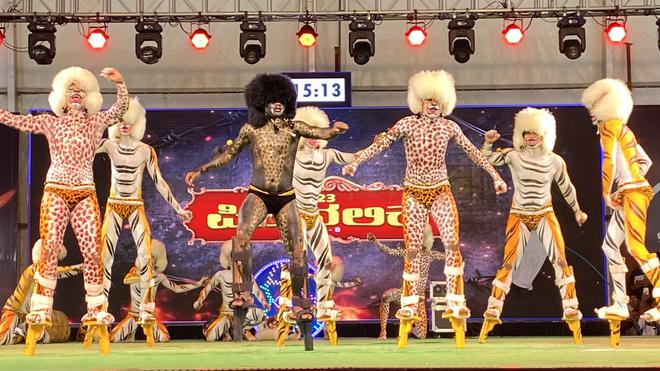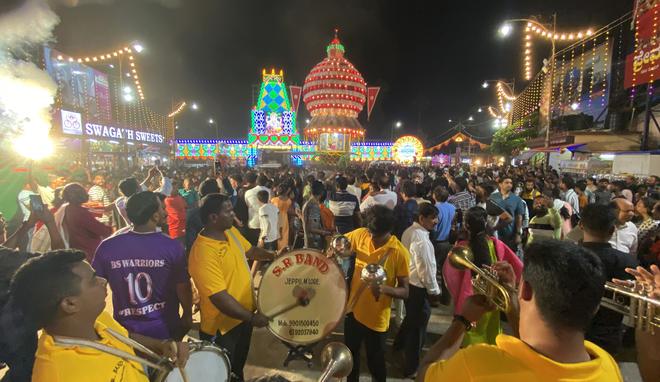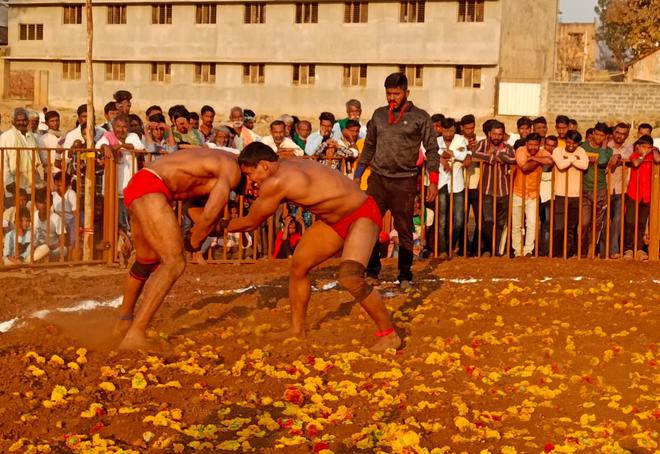Among the places known for Dasara celebrations, other than Mysuru, it is the celebration in Kodagu that stands out. The celebrations in Madikeri and Gonikoppa involve the local public and attract many outsiders. It is said that the erstwhile rulers of Kodagu began the festival celebrations around a century ago. Now, the ruling governments sanction special grants to hold the events associated with the festival with grandeur.
The special attractions of the procession on the final day are four Karagas and 10 bedecked mantaps. The procession that covers major roads in Madikeri continues throughout the night. Karagas taken out of the temples of Shakti Devatas on the first day of the festival join the procession. And 10 mantapas represent the 10 temples of the town.
At Shivamogga, like Mysuru
By and large, the Dasara celebrations in Shivamogga are similar to the events in Mysuru. Every year, the howdah with the idol of the goddess is carried by an elephant as part of the final day procession. However, this year, the procession did not take off as planned earlier. One of the elephants chosen for the procession gave birth to a baby hours before the event, leaving the officers in shock. The officers had chosen Nethravathi, the 25-year-old female elephant, for the event without noticing that it was pregnant.
The officers and elected representatives chose to take out the howdah with the idol of goddess Chamundeshwari in a specially designed vehicle instead of an elephant.
The organizers plan events that involved every cross-section of society. Children and women have competitions to participate in. Youths enjoyed Yuva Dasara. Theatre-lovers have Ranga Dasara, which includes the staging of plays and street plays. Cine stars, popular singers, and television artists are the special attractions of the events, much like how it is in Mysuru. The celebrations come to an end with Banni Pooja and Ravana Dahana, a ritual of burning an effigy of Ravana. The city corporation is estimated to have spent around ₹1.8 crore for the celebrations this year.
In the coastal region
What drives the crowd in Mangaluru during Dasara celebrations is the variety of cultural events organised as part of the festival. Undoubtedly, ‘tiger dance’ is the special attraction of Dasara in the coastal district.
As many as 15 teams took part in the Pili Parba, a tiger dance competition held by Kudla Samskritika Prathisthana at Nehru Maidan on October 21 this year. Each team was given 20 minutes to perform. A similar event was held at Mangaluru International Airport on the previous day. Besides the tiger dance, the event included music and dance as well. The festivities ended with a procession of idols of Sharada and Nava Durgas and a chariot festival of Mangaladevi Temple.


In many mutts
Along with the kings and rulers, Navarathri celebrations have been associated with religious institutions. Many mutts celebrate the festival in tune with their traditions. Rambhapuri Peetha of Balehonnur in Chikkamagaluru district held its Sharannavarathri Utsava Dharma Sammelana at Lingasugur in Raichur district, under the leadership of Veerasomeshwara Swamy. The programme includes rituals as well as seminars.
The Navarathri celebrations in Sringeri Sharada Peetha include a series of rituals and cultural programmes. A special Darbar is also held to mark the occasion. Murugha Mutt in Chitradurga holds a series of events during Dasara. For several years, the mutt has been organizing Sharana Samskruthi Utsava. An exhibition is also held on the mutt’s premises. The exhibition includes activities that educate people on various issues including the advances in agriculture, among others.
Siddeshwar Dasara
Dasara is also celebrated with pomp and vigour across Northern Karnataka and in some areas it is quite unique. Bedakihal near Chikkodi, on the Karnataka-Maharashtra border is one such example, where Shri Siddeshwar Dasara is celebrated.
It starts with the Siddeshwara Palaki procession that goes on for nearly 24 hours. It starts in the afternoon on the eve of Dasara and ends with the villagers sharing Banni leaves on Dasara evening.
Several sports and cultural competitions and events are organised. Youth compete in Kabaddi, running and volleyball, while women turn all the village roads into mosaic of colours with Rangolis drawn.
However, the event that draws the largest number of people is wrestling. Champion wrestlers from Karnataka, Maharashtra and Telangana compete. Greats of Indian wrestling like Karthik Kate, Bala Rafiq Shaik, Nithin Madane, Mauli Jamadade and Addu Pehelwan have rolled into the red soil here. “Some wrestlers from Russia have also participated in our village bouts before COVID lockdown,” recalls writer D.S. Chougale who hails from Bedkihal.
A literary fest
Some small towns have turned Dasara into an occasion for creating a platform for intellectual discussion and cultural events. Hangal in Haveri district is one such town. The birthplace of Ambabai, classical singer and mother of Hindustani great Gangubai Hangal, has been organising variety of cultural programmes and lecture series for over 86 years now. Started as `Vasant Sahitya Utsav’ in 1936, it was renamed as `Nada Habba’ in 1937 by Acharya B.M. Shreekanthaiah.
The founding team of Krishna Rao Chimmalagi, A.N. Kundapur, Gajanan Rao Kulkarni , P. T. Desai, and others started holding music and dance sessions, lectures and sports events in the Balabheema Vyayama Shala grounds. It was later shifted to the Grama Kendra grounds. Jnyanapeetha awardees like Da Ra Bendre and Kuvempu, writers Beechi, Ku Ra Seetaram Shastri, Hunasuru Krishnamurthy, Kannada activist and writers Ana Kru and Tharasu, cine actors Uday Kumar and others have addressed crowds here.
The Kannada Sahtiya Sangha in Rangampete Thimmapur in Surpur in Yadgir district too has been organising cultural programmes since 1943. The Sangha is among the Karnataka Rajyotsava awardees this year.
Sri Bhuvaneshwari, the Goddess of Kannada is the reigning deity in the hilltop temple in Yadgir. A team led by priest Shivaram Kattimani has been decorating the temple premises with lamps for nine days. The whole won of Yadgir is decorated with Rangoli and lamps and a procession of elephants and horses is taken out in the main streets on Dasara. Members of the Hindu Seva Samiti distribute food and clothes to devotees who go on a padayatra to Tulaja Bhavani temple in neighbouring Maharashtra.
Beyond border dispute
In the months of October, November and December, the border district of Belagavi makes news for all the wrong reasons. Protests and boycotts by Marathi groups like Maharashtra Ekikaran Samiti hog the news space during the Rajyotsava and winter session. This tends to mask some events that light up the lives of the residents. The season of Navaratri and Dasara is a time of festivities for the city.

In the old city of Belagavi, still called ‘Junnai Belgaum’ by people of vintage, Dasara is a festival with many rituals. Teams of young people walk from the old city areas of Shahapur and Wadagaon to the ends of the city in the Seemollanghana ceremony. Leaves of the Banni tree are shared among relatives, friends, acquaintances and even strangers with the saying, “Let us exchange leaves of gold and live golden lives.”
The celebrations start at the Vidya Niketan grounds near St. Xaviers school. The Vatandar Patil family performs pooja to the palanquins carrying various deities like Venkataramana, Maruti, Jyotiba and Durga.
Residents of the military camp area celebrate Dasara differently. The Pujari family claim to have started the ritual of organising a procession of palanquins in the 1900s. The deities include Mariyamma , Muthu Mariamma and Kunti. Youngsters wearing masks of animals dance to the tunes of devotional and popular songs.
Support of Adil Shahis
The annual car festival of the Sri Venkateshwara temple is organised in Vithal galli in Shahpur. “The Adilshahis of Bijapur provided annual grants to the Naik family of Shahapur to organise the festival. But after independence, the government stopped supporting such festivities. All the assistance is given to the Dasara in Mysuru,’‘ says Sakharam Dhond, a resident of Shahapur.
In recent years, Hindutva organisations like Shiva Pratishtan and Sri Ram Sena have been organising Durga Mata Daud, a morning run for nine days of Navaratri, in Belagavi and in recent times other places too. Hundreds of girls and boys join the run. Those who play musical instruments join the band. The runners are called Dharkaris the Marathi term for warrior. This is reminiscent of Warkaris, or devotees who participate in a fortnight long padayatra to the Vithal Mandir in Pandharpur. The run is organised in nine different residential areas of the city.
Spread of Daud
“The daud started a few years ago and was held only on the main road for the first few years. Its success prompted us to hold it in various locations,” said Shivaji Salunke, one of the organisers in the city. Ramakant Konduskar, Sri Ram Sena Hindustan leader, said the daud was spreading to other towns and villages. “Now there are dauds in towns like Gokak, Hukkeri, Chikkodi and Bailhongal. By next year the number of places will increase,’’ he said, insisting it was non-political.







